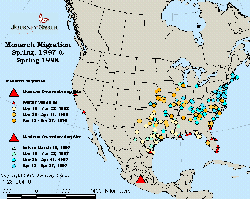Monarch Home Page
Challenge Questions

Today's News

Spring's Journey North

Report Your Sightings

Teacher's Manual

Search Journey North
return to:

Monarch Butterfly Update: April 28, 1998
Today's Report Includes:
- Latest Migration News and Data
- Southern Monarchs Soon to Disappear: Discussion of Challenge Question #10
Latest Migration News and Data
- Link to Today's Migration Data*
* Special thanks to Monarch Watch and Texas Monarch Watch for contributing data for this study.
From Austin, TX Bill Calvert sent these observations:
April 23, 1998
"I am finding that the old, faded monarchs are just about gone now. The first spring generation is now in chrysalis and fifth instar stage. It will be very interesting to see how many bright, shiny first spring generation monarchs are reported in the next few weeks."
And from Gainesville, GA came this news from North Hall Middle School:
April 24, 1998
"Dear Journey North,
We have eggs! After watching and waiting, having seen the first Monarch over a week ago (04/12/98). The results are showing up. We have seen only one Monarch, but the butterfly weeds have a few eggs on them. The Swamp
milkweeds are covered, some leaves have 3 to 4 eggs on them. It has been a very wet and stormy spring, but the Monarchs are still on track. The milkweed plants have almost doubled in height in the past week, from 4 to 8 inches in height. Waiting on larvae..."
Mr. Barton and Students
North Hall Middle School
Gainesville, GA
mmb1984@aol.com
Southern Monarchs Soon to Disappear
Discussion of Challenge Question #10
A few weeks ago, Texas teacher Harlen Aschen mentioned that the monarch season would be over soon. We asked Challenge Question #10: "Why do you think the monarch season 'ends' in Texas during the summer months?"
Here Dr. Bill Calvert gives an overview of the monarch's "seasons" in the South:
 "Here in Austin, TX at latitude 30 N, it's late March
to the 4th week of April for the first spring generation to grow and mature, and it looks like late April to the
4th week of May for the second spring generation to grow and mature. (But if this year is like last, we won't have
much of a second spring generation!) Monarchs disappear sometime in June. (Not all of them, of course, but the
bulk of them.) Then they reappear in early September, or perhaps even late August.
"Here in Austin, TX at latitude 30 N, it's late March
to the 4th week of April for the first spring generation to grow and mature, and it looks like late April to the
4th week of May for the second spring generation to grow and mature. (But if this year is like last, we won't have
much of a second spring generation!) Monarchs disappear sometime in June. (Not all of them, of course, but the
bulk of them.) Then they reappear in early September, or perhaps even late August."The reasons behind this are controversial. Zaluki and Malcolm (monarch biologists) think that monarchs can't survive the heat, e.g. it is the heat per se that kills them. But there are so many reports of monarchs present in high heat that it doesn't seem possible that heat kills them. It may be a simple matter of food plant senescence during the hot summer months.
"What happens here in Texas to the larval food plants depends on the species. Two milkweed species (A. viridis and A. asperula) have a strong growing and maturing spurt in the spring that corresponds with the monarch presence. Both species seem to die back in June and July, essentially
disappearing during the summer.
"Some percentage of these species reappears in the fall. (I estimate about 30%, but only on the basis of an impression.) Seems like more A. viridis reappear than A. asperula, but again these are impressions. A 3rd milkweed species, A. Oenotheroides, is different. It grows in the spring and some of it does flower, but at this latitude most of the flowering occurs in the fall. It also seems to senesce or aestivate during the hot summer. Thus, when the milkweeds reappear, so do the monarchs.
"As I mentioned, monarchs reappear here in early September or even late August. Remember: It is still extremely hot in Texas then, and yet there is a flourishing monarch population. This is the principal reason that I think the system is host plant - not temperature-- driven. (Allowing for the possibility that heat plays a strong role in host plant cycles.)
"Where does this disappearance occur? Which states and/or latitudes and/or max temperatures seem to be the limit? I would guess goes up to latitude 35 N--and from the Atlantic over to West Central Texas - about longitude 102. Seems like it should shoot north up the Central Plains in a manifestation of a continental effect, too. (Its hotter in mid-continent during the summer).
"Zalucki and Malcolm figure the expected ranges of summer caterpillars on the basis of degree days. I am not familiar enough with their work to quote them without looking it up. It could well be that everything correlates with degree days. That is, that the larval host plants senesce because of
the heat and the monarch strategy is to remove themselves from areas of no viable host plants. It would be nice to correlate hot Septembers with abundance of monarchs, but I'm afraid we are not yet so sophisticated."
The Next Monarch Butterfly Migration Update Will be Posted on May 5, 1998.
Copyright 1998 Journey North. All Rights Reserved.





